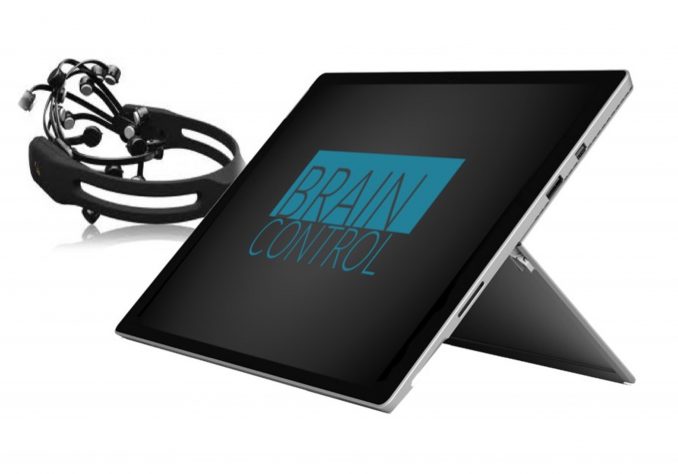
Completely paralyzed, yet able to communicate non-verbally thanks to the power of the imagined movement. That’s what the Italian Liquidweb instrument offers in a tablet format. This start-up participated in the accelerator program of HighTechXL three years ago in Eindhoven, and is now putting into practice what was learned there.
In the film “Le Scaphandre et le Papillon” (The Diving Bell and the Butterfly), Jean-Dominique, a writer, suffers from locked-in syndrome as a result of a stroke. He is completely paralyzed and can only move his left eye. The only way the writer can communicate is by blinking. Once means “yes”, twice means “no.” The strong-willed Jean-Dominique succeeds in writing a book by blinking his eye and with the help of an employee of the publisher who holds up an alphabet for him.
Had Jean-Dominique been familiar with Braincontrol, writing a book and communicating from his sickbed would have been a lot easier. Braincontrol is a medical device that allows paralyzed patients to control movements with their thoughts. The 46-year-old Pasquale Fedele, Braincontrol’s designer, explains how this works.
“Braincontrol is a medical device for patients who were previously healthy but now have serious mobility and communication problems due to illness or an accident. We are talking about patients with Lou Gehrig’s disease. Or people who have suffered a stroke in a specific brain area, or traumatic brain injury from an accident. In the worst cases, they are completely paralyzed and unable to move their muscles voluntarily. They are unable to communicate either verbally or non-verbally. The intellectual and cognitive skills of these patients may still be intact in a number of cases. For example, they can activate the cerebral cortex with conscious thoughts. Braincontrol is able to interpret thoughts related to the patient’s imagined movements. These are movements such as “forward”, “backward”, “right”, “left”, “up” and “turn.” These are exactly the movements that are needed to move a joystick.
How does it work?
“When I raise my hand, that movement is anticipated by an electrical impulse to the cerebral cortex that I generate with my mind. So, even if I can’t move my hand because it’s paralyzed, I can concentrate on that impulse. The electrical signal is then intercepted by electroencephalographic sensors.”
Electroencephalography (EEG) has been around for a long time. What’s new about your invention?
“EEG is normally used for diagnostic purposes to analyze electrical activity in the human brain. In addition to EEG, Braincontrol’s instrument uses a brain-computer interface (BCI). This allows the patient to communicate with a computer using only their brain activity.”

Isn’t it difficult for the patient to evoke a specific thought?
“They receive training so that they can learn to induce control from the brain in an unambiguous way so that there is no confusion with other stimuli to and from the brain. In practice, it always goes well. In addition, Braincontrol is a ‘learning’ device that learns the specific characteristics of a patient over time (machine learning).”
Are there any limits to the device when interpreting the patient’s thoughts?
“Yes, there are. BrainControl can’t interpret all kinds of thoughts. For example, it cannot directly interpret the distinction between ‘cold’ and ‘warm’. The user can control grids via imaginary movements, with predefined words or relevant images and virtual keyboards. This allows the patient to communicate with family members, doctors, and nurses. They can write an e-mail, operate their own wheelchair, etc.”

Is Braincontrol unique in the world?
“Although the development of brain-computer interfaces has been going on for thirty years, Braincontrol is the only medical instrument that has proven itself in this field. Braincontrol is also the only instrument that is certified. It is reimbursed by the Italian health insurance service. Braincontrol works on a tablet and uses a wireless EEG headset.”
How much does Braincontrol cost?
“We have a service-oriented business model: the device is leased and we charge service costs starting at €300 per month. You can also buy Braincontrol for €20,000.”
What’s your next goal?
“With brain-computer interfaces, numerous applications can be devised in all sorts of areas, such as in cars and for the household. In the future, we will no longer communicate with machines solely using a mouse, keyboard or a joystick, but in much more natural ways, such as through a look, a gesture or a thought.
In January we started a trial in a museum in Siena, Italy, where the patient can operate an avatar at home or in the hospital to take a tour with a guide. Because the museum had to close down in March due to the corona crisis, we have extended the trial. Anyone can now book an avatar visit and see what the tourist visit of the future will look like.”
The visit to the museum of Santa Maria della Scala in Siena can be booked (free of charge) via this link. Due to contact with an Italian tour guide, you must be able to understand Italian.

